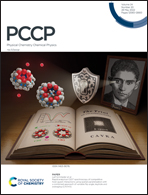Influence of solvents on the morphology of Langmuir and Langmuir–Schaefer films of PCBM and PCBM-based oligomers and polymers†
Abstract
Fullerene-based polymers and oligomers combined with non-fullerene acceptors show extremely high efficiencies in organic photovoltaic devices. Furthermore, fullerene-based materials are of interest for use in anti-cancer and anti-viral treatments, where their presence can enhance the efficacy of medication considerably. Therefore, it remains important to understand their morphology and electronic properties to improve devices and technological applications. The main goal of this study is to prepare and characterize Langmuir and Langmuir–Schaefer films of PCBM-based materials to investigate the influence of different solvents such as chloroform, toluene, and xylene, and co-components on their morphology. PCBM-based materials were thus studied either alone or in mixtures with a polythiophene derivative (poly(3-hexythiophene), P3HT) commonly used in organic photovoltaic devices. The formation of Langmuir films was studied using surface pressure isotherms and Brewster's angle microscopy (BAM), where the homogeneity, phase behavior, and morphology of the films were investigated. In addition, Langmuir–Schaefer films were characterized by UV-visible absorption spectroscopy, atomic force microscopy (AFM), and Raman spectroscopy, providing information on the morphology of the solid films. This study has shown that it is possible to successfully fabricate Langmuir and Langmuir–Schaefer films of PCBM and PCBM-based oligomers and polymers, both pure and in mixtures with P3HT, to compare their organization, roughness, and optical properties. With the Langmuir films, it was possible to estimate the area of the molecules and visualize their aggregation through BAM images, establishing a relationship between the area occupied by these materials and the solvent used. All characterization techniques corroborate that the use of chloroform significantly reduced the roughness of the LS films mixed with P3HT and also presented a higher ordering compared to films prepared with xylene solutions.



 Please wait while we load your content...
Please wait while we load your content...